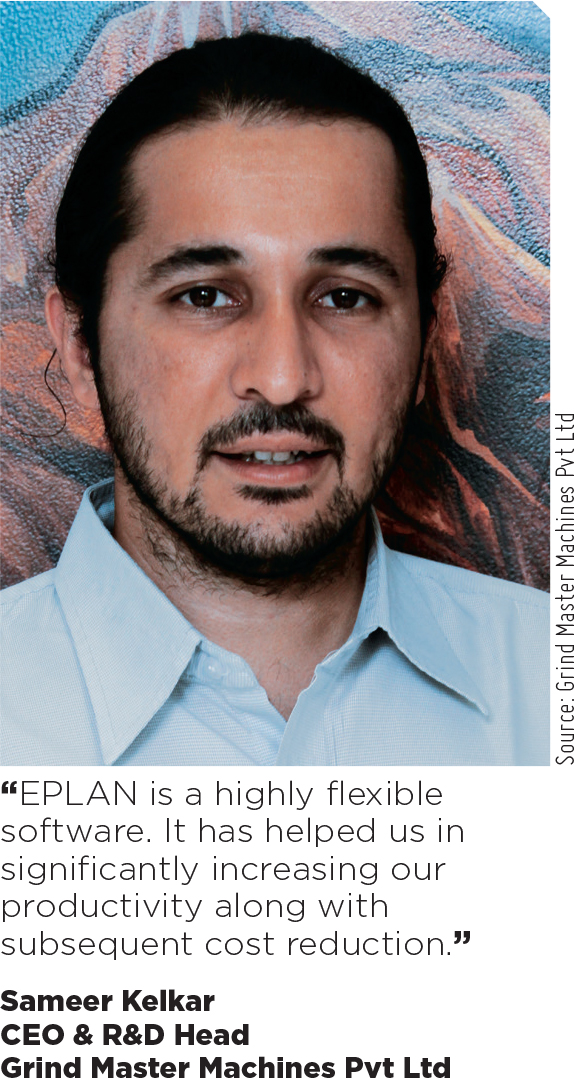Efficient Engineering with EPLAN

The transition from a traditional software to EPLAN has provided Grind Master Machines a greater advantage in terms of increased production rate, reduced cost structure and quick turnaround time.
Established in 1984, Grind Master Machines Pvt Ltd has been successfully manufacturing me-tal finishing and deburring machine tools for the last 33 years. Located in Aurangabad, Maharashtra, India, the company specializes in Metal Finishing, Deburring, Microfinishing, and Robotic Automation.
In addition to India, Grind Master has extended its footprint in China and has been serving customers across India, China, South East Asia, Europe, the USA, and the Middle East countries. Over the years, the company has earned a well-positioned spot in the machine tool industry. With a workforce of 350, including 160 engineers, Grind Master extensively believes in technology and development and is on a mission to become a global technology leader.
Optimizing Engineering Processes
In 2013, Grind Master switched to EPLAN from AutoCAD to optimize its engineering processes. The transition from traditional CAD to EPLAN has provided the company a greater advantage in terms of increased production rate, reduced cost structure and quick turnaround time. The expert design and manufacturing team of Grind Master find EPLAN extremely convenient and reliable in providing quality engineering solutions.
Having recognized huge opportunities, Grind Master migrated to two of the EPLAN products, which are EPLAN Electric P8 and EPLAN Fluid. With EPLAN, Grind Master has been able to tackle time, the scarcest resource of all. A solid platform to work on, EPLAN Electric P8 allows the company’s engineers to easily document and manage every phase of their machinery project. EPLAN Electric P8, which is a design software, is considered a potential choice by engineers for maintaining the reliability, functionality, and speed of a project.
Challenge
Grind Master needed a solution to optimize its engineering processes.
Solution
The company migrated to two of the EPLAN products – EPLAN Electric P8 and EPLAN Fluid. Its transition from traditional CAD to EPLAN has led to increased production rate, reduced cost structure and quick turnaround time.
EPLAN Electric P8 and EPLAN Fluid
Every time a project reaches a certain phase, it is a natural thing to witness at least some percentage of variations from the actual requirement. Manually going through each element of the checklist is time-consuming and unproductive. EPLAN Electric P8, at the press of a button, performs comprehensive check procedures with consistency and efficiency. Post product testing, the EPLAN software is designed to provide engineers with rapid revisions and corrections needed, which is actually a time-saving assistance when compared to tedious manual procedures.
EPLAN Electric P8 helps make a difference. Through this sophisticated support, engineers can smartly plan to build with efficiency. Also, from the initial phase to the final one, the wiring diagrams can be easily modified without any sort of performance degradation. A good amount of time can be conserved through the facility of automatic reports generation that includes BOM creation, terminal diagram, and cable list. Time-consuming tasks such as wire-numbering, device-tagging, cross-referencing and error checking can also be automated.
EPLAN Electric P8’s compatibility with international standards such as IEC, NFPA and Chinese GB standards has enabled Grind Master to easily collaborate with its global clients. With the advantage of Unicode compatibility feature, circuit diagrams, parts list, and other documentation are easily deployed worldwide. The company, in collaboration with EPLAN Electric P8, can now support multilingual parts database to achieve a broadened integration with clients.
In association with another product of the same platform, EPLAN Fluid, Grind Master’s engineers find it easier to step up their fluid power engineering processes through the automated design generation and circuit documentation. EPLAN Fluid is an engineering tool that complies with current ISO standards while auto-generating reports. The EPLAN platform, through a standardized database, makes it possible for engineers to maintain direct communication between electrical, fluid power and electrical I&C engineering processes.
Engineers at Grind Master can see a complete transition in the project lifecycle after having switched to the EPLAN platform. A quick documentation and evaluation process gives the company a good chance to achieve its target with reduced engineering time while promising its clients quick turnaround implementations.
 The Transition Phase : Preparing for EPLAN
The Transition Phase : Preparing for EPLAN
A team of six engineers including one design engineer was trained to adopt EPLAN technology. On-spot support and guidance were provided to keep the team more comfortable about the new adoption. Members on board were thoroughly trained to work on this new platform.
EPLAN is a valuable tool that has increased both efficiency and productivity at Grind Master. From the day this new technology was adopted, the company’s engineers are able to complete their tasks in a faster and better way.
Achieving Workflow Consistency
Prior to EPLAN, Grind Master had consistency issues regarding GA, BOM, and schematic circuits. Today, under EPLAN, complicated panels and schemes are being completed with less number of revisions.
The reduced processing time has increased the service efficiency of Grind Master. With consistency in engineering, time gain, increased quality, and flexibility, there has been a positive impact on the production rate of the company. The advantage of logical functioning and automated reporting has reduced the bottlenecks in the overall workflow. With proper terminal plans, cable schedules and interconnection diagrams, the field service team is witnessing a smoother process. Fewer production delays and quick data modification have enabled Grind Master to provide accurate project quotes. Out of 10, Grind Master has rated EPLAN with 8 due to the efficiency gained in overall terms.
The advantage of logical functioning and automated reporting has reduced the bottlenecks in the overall workflow. With proper terminal plans, cable schedules and interconnection diagrams, the field service team is witnessing a smoother process.




 Facebook
Facebook.png) Twitter
Twitter Linkedin
Linkedin Subscribe
Subscribe